
Study explores PTF microfibers as sustainable concrete reinforcement
YarnsandFibers News Bureau 2025-02-12 15:41:40 – AustraliaA recent study, conducted at the Civil Laboratory of an Australian university, has examined the use of chemically treated Palm Tree Frond (PTF) microfibers as a partial replacement for sand in concrete. The research provides new insights into how sustainability can be improved without compromising concrete’s strength and performance.
The study tested concrete grades C28, C35, and C40, comparing different PTF content levels of the sand volume. The results showed that PTF microfibers improved several properties, particularly the ease of mixing and handling across all concrete grades. The findings highlight the potential of PTF-reinforced concrete for sustainable and energy-efficient construction, especially in semi-structural applications.
During testing, both destructive and non-destructive methods were used to measure different mechanical and thermal properties of concrete containing PTF. The results showed that as the fiber content increased, the mixture’s consistency improved, making it easier to work with. This change in texture was due to the way the fibers interacted with the concrete mix.
The study also found that increasing the amount of PTF in concrete reduced its density. However, higher PTF content also led to greater water absorption, reaching up to 51.2% by the 28-day mark. This increase in water absorption, caused by the natural fibers’ tendency to retain moisture, could present durability challenges in wet environments.
Another important finding was the improvement in thermal insulation. However, researchers emphasized the importance of balancing fiber content, with the best results found at less than 1% for C28 concrete and between 2.3% and 2.5% for higher grades. This balance is crucial to maintain both strength and insulation properties, and combining natural and synthetic fibers could be a possible solution.
Market Intelligence
Ask for free sample Report

experience
Customer Base
dedicated team
Countries Served Worldwide








